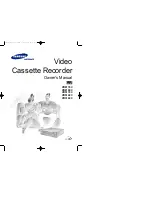
68
Appendix: reference
Front Panel Diagram
AUDIO (LEFT MONO, RIGHT) and VIDEO INPUT Jacks
Receives signals from another
component, such as a VCR or camcorder, when connected through these jacks. to record
from these jacks, use the INPUT button on the remote control to select L2.
CHANNEL TRACKING Up/Down
Selects next higher or lower channel in the VCR’s
channel memory. When a tape is playing, these buttons adjust tracking. Press both
buttons at the same time to recenter tracking.
FWD
Forwards the tape when the VCR is stopped. Searches the picture forward during
playback. Starts slow motion during play-pause and increases slow-motion speed.
INPUT
Toggles between the VCR’s video input channel and regular antenna/satellite
connections. To view the broadcast from an external device (such as a camcorder)
connected to the VCR’s audio/video jacks, tune to the VCR’s Video Line Input.
PLAY/PAUSE
Plays a tape. Pauses action for viewing during playback. Pauses recording
to prevent recording of unwanted scenes.
POWER
Turns the VCR on or off. The power button glows at all times, even when the
VCR is turned off.
RECORD
Starts VCR recording. Also used for Express Recording (XPR).
Remote Sensor
Receives signals from the remote control. Aim the remote at this
sensor.
REV
Rewinds the tape when the VCR is stopped. Searches the picture in reverse during
playback. Starts slow motion during play-pause and decreases slow-motion speed.
STOP•EJECT
Stops normal VCR functions such as record, playback, rewind, fast-forward,
and pause. Ejects the tape when the VCR is stopped.
TAPE SPEED
Selects a recording speed (either SP or SLP).
Transmitter
Transmits signal to a compatible remote-controllable cable box or digital
satellite receiver.
TV•VCR
Switches the picture signal so that it either comes from the VCR or the cable/
antenna system.
POWER
TAPE SPEED
INPUT
TV•VCR
VIDEO
INPUT
LEFTMONO
RIGHT
VIDEO
PLAY
PAUSE
REV
FWD
STOP•EJECT
RECORD
CHANNEL
TRACKING
Remote Sensor
















































